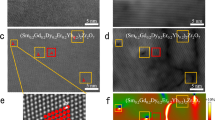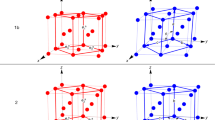Abstract
R. C. VICKERY has stated1 that evidence for more than one crystal structure has been obtained when preparing cerium oxide by igniting various salts of cerium. He classified some preparations he had made into four groups on the basis of density measurements and colour estimations. Referring to work by Wyrouboff and Verneuil, who have suggested that three polymorphic varieties of this oxide might exist, Vickery claimed that a fourth may be indicated as a result of his work. He prepared various salts, starting with the same source of cerium, and fired these for 1 hour at 1,200° C. to secure complete conversion to the oxide. If by this process oxides of different crystal structure are really produced, important and far-reaching effects on solid reactions generally can be envisaged.
This is a preview of subscription content, access via your institution
Access options
Subscribe to this journal
Receive 51 print issues and online access
$199.00 per year
only $3.90 per issue
Buy this article
- Purchase on SpringerLink
- Instant access to full article PDF
Prices may be subject to local taxes which are calculated during checkout
Similar content being viewed by others
References
Vickery, R. C., Nature, 160, 830 (1947).
Author information
Authors and Affiliations
Rights and permissions
About this article
Cite this article
HARWOOD, M. Variation in Density and Colour of Cerium Oxide. Nature 164, 787 (1949). https://doi.org/10.1038/164787a0
Issue Date:
DOI: https://doi.org/10.1038/164787a0
This article is cited by
-
Adsorption of the halogens on cerium dioxide
Microchimica Acta (1975)



